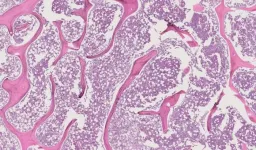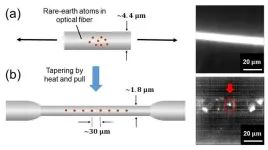(Press-News.org) Research out of Drexel University’s College of Engineering suggests that over the next two decades people living in the Schuylkill Watershed, which includes Philadelphia, could experience as many as 82 more days of water shortfalls due to localized weather impacts of climate change. The projections, which account for changes in population, land use, and climate, indicate that — due to more frequent extreme weather events associated with climate change — the watershed may only be able to meet demand about 67% of the time, a drop of 22% from its current reliability.
Published in the journal Water, the paper is the first to look at the compounding effects of climate change and land use and land cover changes on the natural processes that replenish the Schuylkill watershed. The reductions in streamflow and groundwater stores could equate to drought-like conditions where there will not be enough water to meet the region’s water demand for drinking, irrigation, transportation, energy generation, recreation, and sustaining aquatic ecosystems, according to the researchers.
“The gap between available water and demand is expected to require difficult tradeoffs,” said Mira Olson, PhD, an associate professor in the College of Engineering and principal investigator of the study. “Our current resource management practices do not account for increases in the number of extreme precipitation events coupled with population growth and a related shift in land cover that will result in more runoff — rather than water retention.”
Using a mathematical modeling environment programmed to simulate streamflow based on current watershed management policies, the research team, which included Patrick Gurian, PhD, a professor in the College of Engineering, and former students Achira Amur, PhD, now a post-doctoral researcher at Villanova University, Suna Ekin Kali a doctoral student at Luleå University in Sweden and Lena Champlin, PhD, a post-doctoral researcher at Boston University, pulled in soil and land cover data from the U.S. Geological Survey and regional precipitation models from the World Climate Research Programme to make its projections.
After successfully recreating the hydrological dynamics of the Schuylkill watershed in the modeling environment, the team could then change various inputs — from greenhouse gas emission scenarios to population growth in cities and suburbs and their resulting land use changes — to simulate the effects of future climate conditions on the area’s water supply.
Perhaps counterintuitively, the variable that caused the largest increase in projected water shortfalls was an increase in extreme precipitation events. The researchers explained this is because the soil and land cover within the watershed limit how quickly water can be absorbed and how much can be stored at one time. So, while steady rain over a long period of time can replenish a watershed, downpours result in water runoff that is not captured and stored.
Unfortunately, such an uptick in extreme weather events coupled with less precipitation overall during warm seasons, is precisely what climate data, localized from the Intergovernmental Panel on Climate Change, is projecting for the Philadelphia region from 2020 to 2040.
What this all means is that water management authorities may need to adjust the policies that govern when and how much water is released from reservoirs to satisfy downstream demand in the watershed area.
“Watershed management requires maintaining a careful balance between the amount of water stored in the ground and natural bodies of water and the amount intentionally retained and released from reservoirs to make up for extended dry stretches in the hydrological cycle. All of these are subject to substantial uncertainties,” Gurian said. “For this reason, we considered multiple climate models, emissions levels, and development scenarios.”
These stretches, the authors note, could result in more frequent low-flow conditions in streams and bodies of water which, coupled with higher temperatures, would result in more evaporation, further exacerbating the problem and requiring management interventions.
“Our current management policies are based on the historical precipitation patterns we’ve experienced over the last 100 years or so, but in just a couple decades that weather is going to be very different and it’s going to require a rebalancing of the system,” Champlin said.
The results of the study are similar to projections made and conditions already being experienced across North America, including the effects of development and extended drought conditions causing dangerously low levels in reservoirs that serve much of southern California, Nevada and Arizona. While the effect on Philadelphia may not be as dire, the authors suggest that their study represents enough of a warning to justify taking a closer look at the region’s water management strategy.
“This finding and this type of modeling is increasingly important as we’re seeing watershed crises unfold in real time across the country,” Amur said. “While climate change is a problem that needs to be addressed on a global scale, understanding its future impacts at a regional level gives us the opportunity to make preparations that could mitigate some of these water shortages and other challenges associated with climate change.”
The next steps for this research, the authors suggest, should involve modeling development that includes green infrastructure and incorporates more detailed data on future climate and land use projections. They would also recommend improving future models to incorporate regional differences in population growth trends to provide a higher resolution picture of the future of the watershed.
"Our findings provide a roadmap for what lies ahead,” Kali said. “To secure the Schuylkill Watershed's ecosystem services, we must not only adapt our practices but also advocate for collaborative efforts in system and policy adaptation for a more resilient and sustainable future.”
END
Drexel University study projects more water shortfalls in Schuylkill Watershed in next 20 years due to climate change
Philadelphia region could experience as many as 82 more days of water shortfalls due to localized weather impacts of climate change
2023-11-02
ELSE PRESS RELEASES FROM THIS DATE:
National Jewish Health doctors identify health disparities for indigenous coal miners with black lung disease
2023-11-02
Researchers at National Jewish Health found that Indigenous coal miners may develop disabling black lung disease but are less likely to qualify for medical benefits using currently required lung function standards rather than standards specific to Indigenous populations.
Black lung (also called coal worker’s pneumoconiosis) is a debilitating respiratory illness that can occur several decades after a miner’s first exposure to coal mine dust. Disease severity can be influenced by adequacy of dust controls, medical surveillance programs ...
Can acupuncture alleviate certain kinds of chest pain?
2023-11-02
Researchers at the University of Illinois Chicago have received a $3.12 million National Institutes of Health grant to study whether acupuncture can alleviate chest pain caused by stable angina. Stable angina is defined as predictable chest pain during exertion or when under mental or emotional stress and is a condition that affects millions of Americans.
A large body of research has shown that acupuncture can help mitigate many types of chronic pain. But little is known about its effect on ischemic pain, which is caused when the heart isn’t getting enough oxygen, as is the case with stable angina.
The two-site study will be led by principal investigators Judith Schlaeger, ...
Investigators examine shifts in coral microbiome under hypoxia
2023-11-02
Washington, D.C.—A new study published in Applied and Environmental Microbiology, a journal of the American Society for Microbiology, provides the first characterization of the coral microbiome under hypoxia, insufficient oxygen in the water. The research is an initial step toward identifying potential beneficial bacteria for corals facing this environmental stressor.
The researchers conducted the study because of the increasing awareness of the impact of the microbiome on host health. For example, a healthy human gut microbiome plays key roles ...
Johns Hopkins Medicine researchers create machine learning model to calculate chemotherapy success in patients with osteosarcoma
2023-11-02
A research team at Johns Hopkins Medicine has created and trained a machine learning model to calculate percent necrosis (PN) — or, what percentage of a tumor is “dead” and no longer active — in patients with osteosarcoma, a type of bone cancer. The model’s calculation was 85% correct when compared to the results of a musculoskeletal pathologist. Upon removing one outlier, the accuracy rose to 99%.
A post-chemotherapy PN calculation helps provide the patient with a prognosis for survival. For example, a PN of 99% indicates that 99% of the tumor is dead, suggesting chemotherapy was effective and the patient has improved ...
Regenstrief’s Hickman to be inducted as Gerontological Society of America fellow
2023-11-02
INDIANAPOLIS — Regenstrief Institute’s Susan Hickman, PhD, has been elected as a fellow of the Gerontological Society of America (GSA). Dr. Hickman will be inducted on November 9 into the social research, policy and practice section of the GSA College of Fellows during the society’s 2023 annual scientific meeting.
In addition to being director and a research scientist with the IU Center for Aging Research at Regenstrief Institute, Dr. Hickman is a professor at Indiana University School of Nursing, the Pettinga Chair in Aging Research with the Indiana University School of Medicine and the co-director of the IUPUI ...
Menopause and heart health – 4 tips for a healthy heart while your body is changing
2023-11-02
DALLAS, Nov. 2, 2023 — Medical experts note that hormone and body composition changes during the transition to menopause can increase the risk of developing heart disease after menopause.[1] The American Heart Association, a global force for healthier lives for all, offers tips to support women’s heart health during this transition.
“More women in the U.S. are living longer, and a significant portion of them will spend up to 40% of their lives postmenopausal,” said Brooke Aggarwal, Ed.D., M.S., F.A.H.A., assistant professor of medical sciences in Cardiology ...
Self-powered microbial fuel cell biosensor for monitoring organic freshwater pollution
2023-11-02
The discharge of organic effluents—biodegradable waste materials from plants and animals—into freshwater bodies is a significant environmental concern, affecting the health and sustainability of these aquatic ecosystems. However, the methods currently available for inspecting water quality are complex and costly.
In this regard, researchers from Ritsumeikan University, Japan, have recently developed a self-powered, inexpensive, and floating biosensor for monitoring water quality at the input of freshwater lakes and rivers. This paper was made available online on September 9, 2023, and was published in Volume 200 of the Biochemical Engineering ...
Optical-fiber based single-photon light source at room temperature for next-generation quantum processing
2023-11-02
Quantum-based systems promise faster computing and stronger encryption for computation and communication systems. These systems can be built on fiber networks involving interconnected nodes which consist of qubits and single-photon generators that create entangled photon pairs.
In this regard, rare-earth (RE) atoms and ions in solid-state materials are highly promising as single-photon generators. These materials are compatible with fiber networks and emit photons across a broad range of wavelengths. Due to their wide spectral range, optical fibers ...
The influence of media narratives on microplastics risk perception revealed
2023-11-02
In a world increasingly aware of the environmental challenges posed by microplastics, a pioneering study conducted by Ruxandra Malina Petrescu-Mag from Babes-Bolyai University, and published in PeerJ Life & Environment, sheds new light on the impact of media narratives on public perception and awareness of microplastic risks.
Microplastics - tiny plastic particles that pollute both terrestrial and marine ecosystems - have garnered significant scientific, media, and public attention in recent years. However, this study reveals a lack of consensus between the scientific community and the media, particularly when it comes to how ...
TU Delft researchers discover new ultra strong material for microchip sensors
2023-11-02
Researchers at Delft University of Technology, led by assistant professor Richard Norte, have unveiled a remarkable new material with potential to impact the world of material science: amorphous silicon carbide (a-SiC). Beyond its exceptional strength, this material demonstrates mechanical properties crucial for vibration isolation on a microchip. Amorphous silicon carbide is therefore particularly suitable for making ultra-sensitive microchip sensors.
The range of potential applications is vast. From ultra-sensitive microchip sensors and advanced solar ...
LAST 30 PRESS RELEASES:
Fires could emit more air pollution than previously estimated
A new way to map how cells choose their fate
Numbers in our sights affect how we perceive space
SIMJ announces global collaborative book project in commemoration of its 75th anniversary
Air pollution exposure and birth weight
Obstructive sleep apnea risk and mental health conditions among older adults
How talking slows eye movements behind the wheel
The Ceramic Society of Japan’s Oxoate Ceramics Research Association launches new international book project
Heart-brain connection: international study reveals the role of the vagus nerve in keeping the heart young
Researchers identify Rb1 as a predictive biomarker for a new therapeutic strategy in some breast cancers
Survey reveals ethical gaps slowing AI adoption in pediatric surgery
Stimulant ADHD medications work differently than thought
AI overestimates how smart people are, according to HSE economists
HSE researchers create genome-wide map of quadruplexes
Scientists boost cell "powerhouses" to burn more calories
Automatic label checking: The missing step in making reliable medical AI
Low daily alcohol intake linked to 50% heightened mouth cancer risk in India
American Meteorological Society announces Rick Spinrad as 2026 President-Elect
Biomass-based carbon capture spotlighted in newly released global climate webinar recording
Illuminating invisible nano pollutants: advanced bioimaging tracks the full journey of emerging nanoscale contaminants in living systems
How does age affect recovery from spinal cord injury?
Novel AI tool offers prognosis for patients with head and neck cancer
Fathers’ microplastic exposure tied to their children’s metabolic problems
Research validates laboratory model for studying high-grade serous ovarian cancer
SIR 2026 delivers transformative breakthroughs in minimally invasive medicine to improve patient care
Stem Cell Reports most downloaded papers of 2025 highlight the breadth and impact of stem cell research
Oxford-led study estimates NHS spends around 3% of its primary and secondary care budget on the health impacts of heat and cold in England
A researcher’s long quest leads to a smart composite breakthrough
Urban wild bees act as “microbial sensors” of city health.
New study finds where you live affects recovery after a hip fracture
[Press-News.org] Drexel University study projects more water shortfalls in Schuylkill Watershed in next 20 years due to climate changePhiladelphia region could experience as many as 82 more days of water shortfalls due to localized weather impacts of climate change



